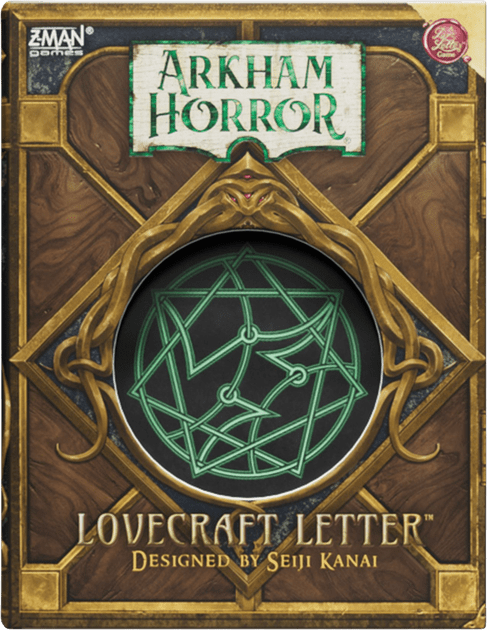SMOOSH JUICE
Developer Diary: Arkham Horror: Lovecraft Letter | BoardGameGeek News

by Jorge Zhang
Hi, everyone, I led the development of Z-Man Games‘ Arkham Horror: Lovecraft Letter, a refresh of Seiji Kanai‘s popular Lovecraft Letter game from 2017, which was itself a reimplementation of his 2012 Love Letter, and I am here to share a few of the changes we made.
Designing R’Lyeh and Tommy Gun
To keep this update fresh, I added two new cards to the game: “Tommy Gun” and “R’lyeh”. These cards are both numbered 0, and only one copy of each exists in the deck.
“Tommy Gun” takes the top two cards of the deck and places them in any player’s play area; “R’lyeh” does the same thing, while carrying an insane effect that flips the deck upside down and allows you to end the round early at the start of your next turn. When designing these cards, it was important to me to design effects that would speed up round length to counterbalance the round-lengthening effect of adding more cards to the deck.
One of the early things I tried with “Tommy Gun” was to place cards in a player’s play area until an Other World card was found. This felt balanced to me because I tend to play the game by embracing insanity, but I got some interesting feedback that this card felt unfair and too strong.
I realized that many people approach the game in a different way: by avoiding insanity at all costs. This effect is compounded by the fact that in other Arkham Horror games, going insane is a loss condition. By adding randomness into the effect, it played a lot better by making the effect feel better regardless of the way players approach the game.
The design of “R’Lyeh” was inspired by one of my favorite Yu-Gi-Oh! cards: “Convulsion of Nature”. Initially, this effect started as a sane effect that simply flipped the deck upside down. It played well, but as when you have too many desserts, it got repetitive once it happened too frequently.
I then tried making the card an insane effect, and while it happened a lot less frequently, flipping the deck wasn’t strong enough to warrant being an insane effect.
At about the same time, I was tinkering with a card that would end the round early. The issue with this effect is that sometimes there isn’t enough information to make a good call as to whether ending the round is a good idea. Combining these cards ended up being a perfect match; seeing the top card of the deck for a round helps a lot in gathering enough information to make a good judgment call on ending the round early.
Cleaning Up Terminology and Rules
A lot of older Love Letter editions didn’t distinguish clearly between the terms “discarding a card” and “playing a card”, and Lovecraft Letter was no exception.
In fact, to compound issues, sanity checks were another form of discarding cards. At first, this seemed like an easy lift, but rule issues kept cropping up at weird places. For example, what happens when you discard the Sane/Arkham 8 through a sanity check? In the original Lovecraft Letter, making this sanity check would be considered a discard, so you would be out of the round. Once I defined sanity checks as separate from discards, it made more sense to rule in the other direction, which is what I ended up doing.
Discarding being separate from playing also caused issues for the insane effects of the 2 and the 5. In the original, these cards allowed you to essentially take a second turn as they discarded cards for an effect (compared to the Sane 5 that discards with no effect). To keep the game faithful to this idea, these effects needed to be carefully reworded.
In other areas, I decided to depart from the original rules to make the game play in a more natural manner. For example, the Other World 7 occasionally winning without needing to play the card was a weird edge case that got shaved off.
One change that led to much internal debate regarded the handling of tiebreakers. There was a strong argument that to be faithful to the original Lovecraft Letter, players with the same number in their hand should be knocked out at the end of the round. Modern versions of Love Letter work differently, with all tied players gaining a victory token. I was concerned that this rule caused too many issues to be worthwhile, especially regarding situations in which no one wins the round, so the harsh tiebreaker rule ended up being removed.
Conclusion
Working on this project humbled me in terms of understanding the difficulty of refreshing an older game, but I am happy with where we ultimately ended up. I am excited to see this out-of-print game get into the hands of more players. Let me know if you have any questions in the comments, and thank you for reading!

/pic8544768.png)
/pic8544779.jpg)
/pic8544855.png)
/pic8544856.png)
/pic8544845.png)